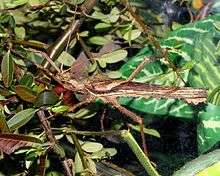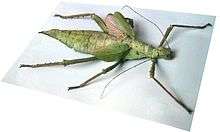Heteropteryx dilatata
Heteropteryx dilatata[1] is a large species stick insect, in the monotypic genus Heteropteryx[2] and typical of the family Heteropterygidae. It is commonly kept in captivity and may be known as the: jungle nymph, Malaysian stick insect, Malaysian wood nymph, Malayan jungle nymph, or Malayan wood nymph. It originates in Malaya and is nocturnal. This insect holds the human record for the largest egg laid by an insect. The eggs are about 1.3 cm (0.5 in) in length.[3]
| Heteropteryx dilatata | |
|---|---|
 | |
| male | |
 | |
| female Heteropteryx dilatata from Malaysia | |
| Scientific classification | |
| Kingdom: | Animalia |
| Phylum: | Arthropoda |
| Class: | Insecta |
| Order: | Phasmatodea |
| Infraorder: | Areolatae |
| Family: | Heteropterygidae |
| Subfamily: | Heteropteryginae |
| Genus: | Heteropteryx |
| Species: | H. dilatata |
| Binomial name | |
| Heteropteryx dilatata (Parkinson, 1798) | |
| Synonyms | |
| |
Description
Females reach a length of 15 centimetres (5.9 in), one of the world's heaviest insects, and the males a length of 10 centimetres (3.9 in).[4] The females of this species are very aggressive and much larger, wider, and brighter-colored than the male. The female is lime green and has short, rounded wings, however their short length doesn't allow them to fly. The males are much smaller and a mottled brown colour. Both sexes have small spikes on their upper bodies, more numerous in the female, who also has very large spines on her hind legs that can snap together as a scissor-like weapon.[5]
Reproduction
Females are born a beige color, which fades as it molts, while the male is a darker brown. This species produces sexually. The female will deposit the dark, circular eggs in moist soil. The eggs take from 12 to 14 months to hatch.[6]
Captivity
They eat bramble, oak, blackberry, raspberry, and ivy, along with other leaves. Their temperature conditions should be between 20 °C (68 °F) and 30 °C (86 °F) and should have a high humidity level, provided by spraying the enclosure with water. They live up to two years in captivity.[7]
Gallery
 Adult male
Adult male Adult female
Adult female- An adult pair; the male, smaller, on top of the female
 Eggs
Eggs
References
- Parkinson (1798) Trans. Linn. Soc. Lond. 4(1): 190.
- Gray GR (1835) Synopsis of the species of insects belonging to the family of Phasmidae 13, 32.
- Guinness World Records 2013, Page 050, Hardcover Edition. ISBN 9781904994879
- Davies, A.; Siwanowicz, I. (2007). Super-Size Bugs. Sterling Publishing Company Incorporated. p. 4. ISBN 9781402753404. Retrieved 2015-08-27.
- "SpeciesFile 28/09/2009 - Phasmid Study Group". phasmid-study-group.org.
- Pearce-Kelly, P.; Clarke, D.; Robertson, M.; Andrews, C. (2007). "The display, culture and conservation of invertebrates at London Zoo". International Zoo Yearbook. 30: 21–30. doi:10.1111/j.1748-1090.1991.tb03460.x.
- "Jungle Nymph - Heteropteryx dilatata | Keeping Insects". keepinginsects.com. Retrieved 2015-08-27.